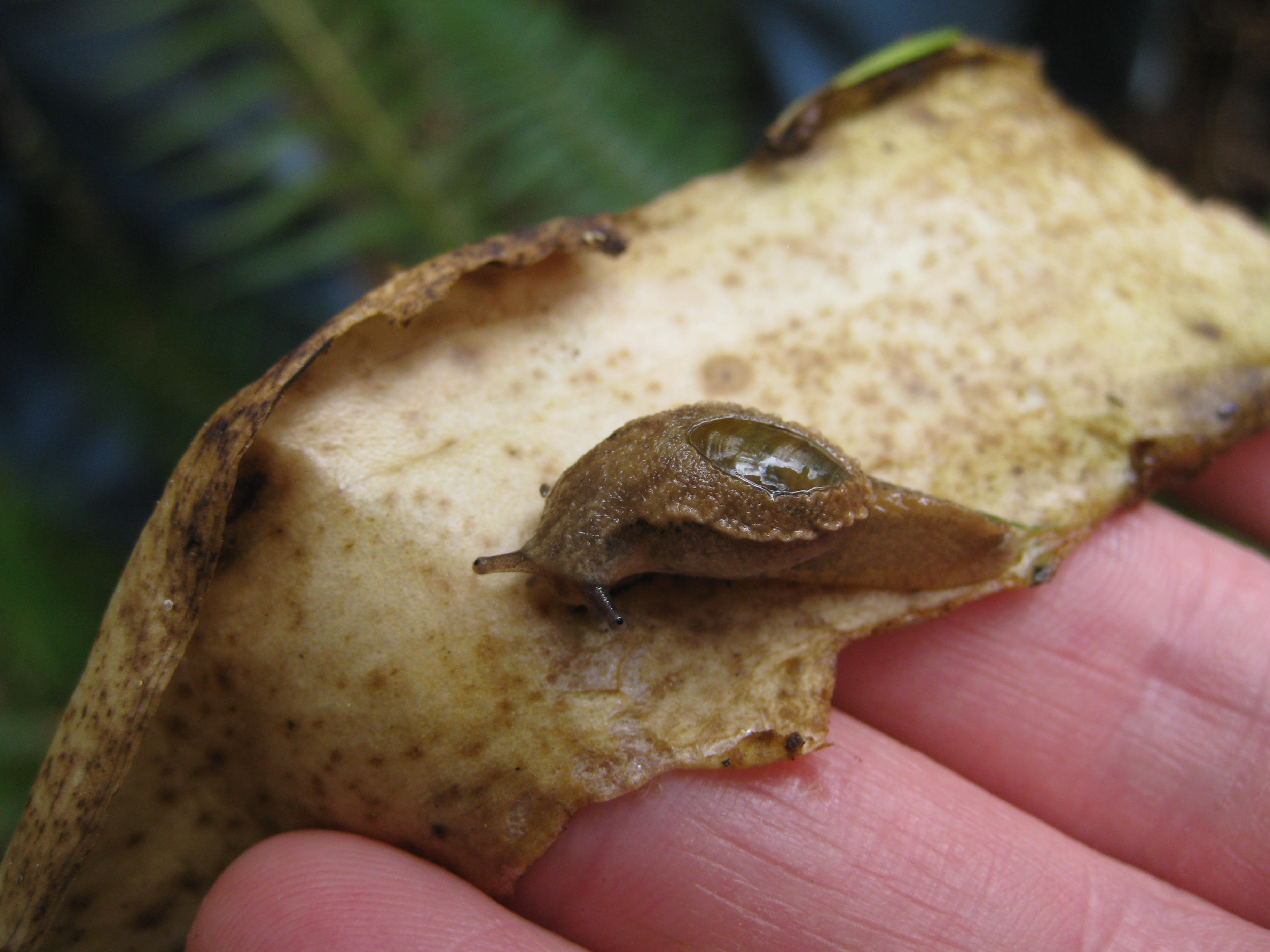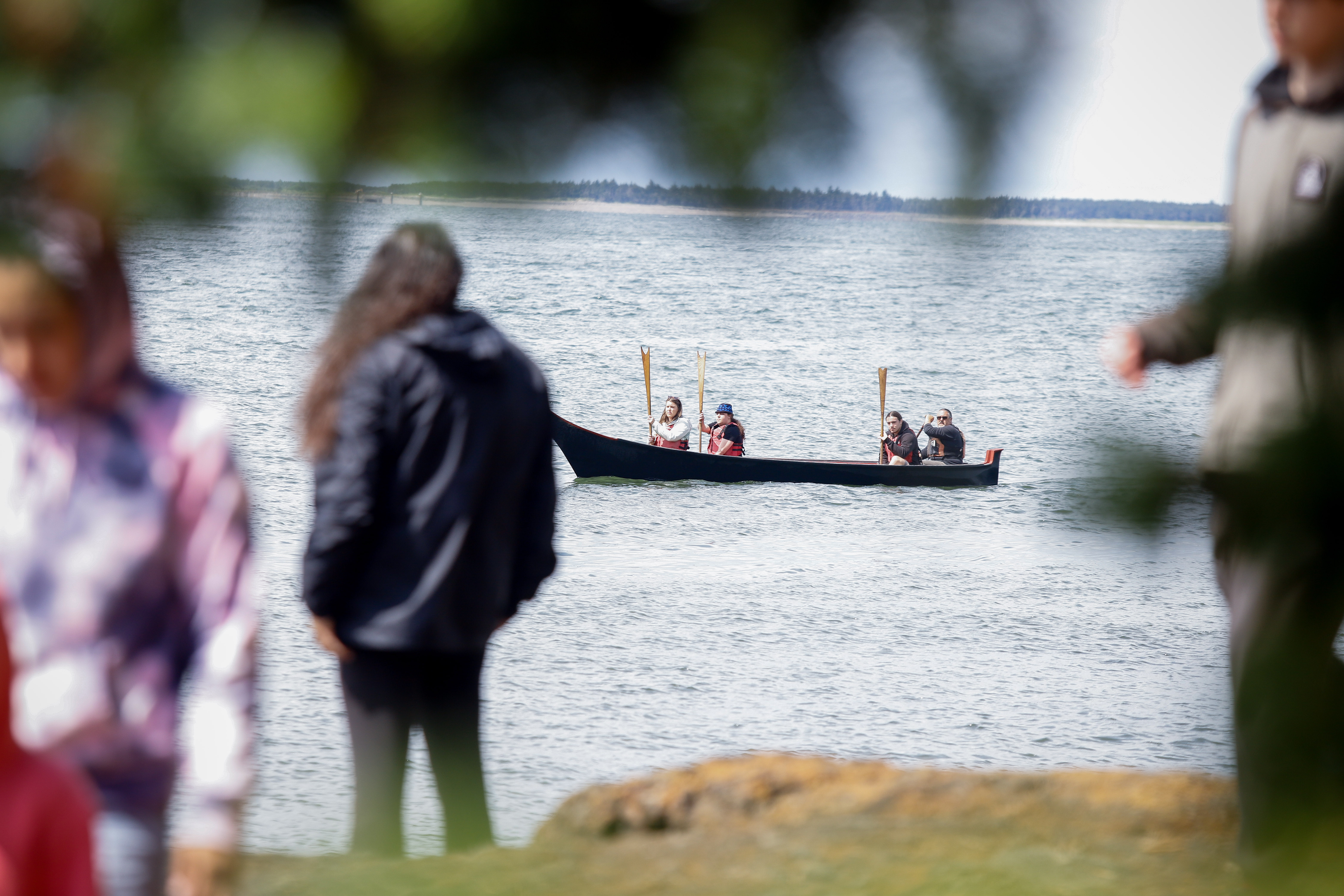It almost went smoothly: Optimism prevails over sprayer’s mechanical problems
Published 5:00 pm Tuesday, August 6, 2002

- LEVI PULKKINEN photo Despite mechanical setbacks, a new computer-assisted sprayer showed strong promise last week of playing a key role in helping control invasive spartina grass on the Willapa tide flats.
WILLAPA BAY – The machine was doing more or less what it was supposed to do, leaving a herbicide mist in its wake. Red LED lights blinked as sprayer heads found plants to kill. Lines grew on the digital map above operator Jonathan Bates’ throttle hand as a John Deere diesel engine – absolutely roaring – pushed the tank-come-tractor along slowly.
Then the machine shuddered. We kept moving.
Then the machine shuddered again. We stopped.
Willapa National Wildlife Refuge manager Terri Butler stepped over the side, into the grass and mud. Over the engine’s din, she signaled to Bates for a flashlight and began examining the left track and he jockeyed the machine back and forth. After five or 10 minutes, she pulled a plastic roller the size of a baseball out of the track and the spraying continued.
As part of an effort that has had more setbacks than successes, Butler, Bates and the rest of the U.S. Fish and Wildlife Service’s spartina-killing team rolled out an old industrial mower retrofitted with chlorophyll-sensing spray heads for the first time early last week. When spraying began, they hoped to treat 500 acres of the invasive grass with the herbicide Rodeo before the tide run finished at week’s end. Though they didn’t reach their goal because of mechanical setbacks and windy weather, last week’s spraying still may mark a turning point in the war against spartina.
1,000 acres
Not long after Kim Patten arrived at the Washington State University’s Long Beach extension office in 1990 he was taken to see a 20-by-30 foot patch of spartina grass growing in Willapa’s South Bay. At the time, the invasive grass seemed to pose little threat to massive bay.
“In 10 short years, it has gone from a few small clones to miles and miles of spartina,” Patten said. “If you’d started work back then, it would have been a piece of cake.”
Today, researchers estimate spartina has taken over 5 to 6,000 acres of the bay and is growing by roughly 20 percent each year, to double in size every five years. In some parts of the bay it may be growing at more than 30 percent each year, said Miranda Wecker, University of Washington Olympic Natural Resource Center manager.
“We are at a point in the spread that if we don’t reverse it in the next couple of years it will far exceed our ability to ever deal with it,” Wecker said. “Unfortunately where it is growing the fastest also happens to be where the best habitat is. We’re losing the best habitat, and we’re reaching that point of no return.”
Because spartina retains sediment in its root structure, it raises the level of the tidal flats it grows on, destroying prime shore bird habitat. A key stop on the Pacific flyway, Willapa Bay provided thousands of migratory birds with an easy meal before the spartina began taking over. Refuge project leader Charlie Stenvall said killing spartina is the first step toward restoring bird habitat and stabilizing the Pacific flyway.
To effectively stop spartina’s growth, agencies must kill – not simply treat, but kill – 1,000 acres of spartina each year. To do so, Wecker said the agencies will need to treat between 2,500 and 3,000 acres each year in addition to re-treating last year’s work.
In 2001, the four concerned federal and state agencies – Washington state’s departments of Agriculture and Natural Resources as well as state and federal Fish and Wildlife Departments – treated 900 acres combined. In doing so, they set the record.
“It’s spreading by much more than we’re being able to kill it,” Wecker said.
While US Fish and Wildlife’s new machine didn’t spray anywhere near the number of acres necessary to stay the grass’s advance, it did treat more spartina than any platform before it.
“They’re doing in one week what others haven’t done in 5 years,” Patten said.
Control
In many ways, the story of spartina control is one of unrealized promise. Hoping that new tools will help them turn the corner on the grass, agencies have invested millions of dollars in failed solutions. Patten said that when spartina became a problem a decade ago, the agencies bought amphibious mowers and converted ski-slope groomers, all of which turned over mediocre results. Simple solutions have failed as well; Washington state Department of Agriculture employees pull spartina by hand, covering but a few acres each summer.
Though the agencies have had some success tilling or crushing the grass, Patten said the Rodeo is most effective method they have found thus far. Limited by both the herbicide’s image – “It connotes things that are not Mom and apple pie,” Patten said – and its environmental costs, agencies also have had problems acquiring funds for their herbicide war chest. Refuge workers were only able to spray this summer after receiving grant money from Friends of Willapa Bay, a local non-profit organization.
Though the chemical works well in the south bay – the site of US Fish and Wildlife’s most recent application – Patten said Rodeo would be less affective in other parts of Willapa Bay because of its long drying time.
“In that particular part of the bay you’ve got really long drying times. If you’ve got enough dry time, Rodeo is a pretty good control method.” Patten said. “You could get it to work with lower dry times, [but] it’s just not cost effective.”
Complicating maters, the state and federal agencies have yet to agree on a plan of action, leaving each working alone. While most agencies purport that – given the proper resources and leeway – the spartina could be eliminated in six years, none have put forth a plan for removal.
“What has not been done is develop a bay-wide strategic plan,” Patten said. “If you don’t do that, you’re never going to get there.”
Patten said the agencies have a working idea of how they could kill spartina collectively, but manmade problems frustrate the effort.
“If you had a good strategic plan, it is very possible [to wipe out spartina in 6 years], Patten said. “The unpredictable component is the human part of it. The human species is a little more difficult to deal with.”
He said agencies often commit themselves ideologically to specific types of spartina control – whether they be chemical, mechanical or biological – when an integrated approach would be more affective.
“People get very attached to their own control methods; whatever they’re doing is the best,” Patten said. “They’re not particularly interested in changing their paradigm of control.”
For good or ill, US Fish and Wildlife is not immune to the trend: while its new machine is technologically a step beyond the service’s older fan boats and hand-held sprayers, it too is a Rodeo-application platform.
Sensors, satellites and the need for a plan
US Fish and Wildlife’s new machine incorporates a number of new technologies hoping to address concerns developed during the last five years, including infrared sensors, mapping equipment and a precision pesticide-mixing system.
After removing the mowing machinery, contractors attached two booms to a mower the service bought in 1996. The booms carry a series of WeedSeeker sprayer heads produced by Patchen Inc. designed to detect and spray chlorophyll. By not spraying empty areas, the heads are designed to save applicators time and money. Though widely used by farmers and transportation authorities for weed control, this is the first time they’ve been tried in an estuarine environment.
Initially, the sensors provide little benefit; because the spartina fields are heavily vegetated, the sprayers are on almost constantly. However, Wecker said the new technology will become more valuable when applicators return next year to “mop up” spartina clones that survived this year’s spraying.
“That’s the promise of the machine; you can treat hundreds of acres quickly. It really is the wave of the future,” Wecker said.
Wecker said that, regardless of this particular machine’s success, a way to clear out the remaining spartina must be developed.
“To really treat it, to really get rid of it, you’ve got to spray it multiple years,” Wecker said. “We’re hoping this will work, but we’re going to need something like that or we’ll be out there spraying by hand.”
Even if applicators get optimal results they will only kill about 95 percent of the spartina they spray, leaving some plants to reproduce and develop resistance to the pesticide if they are not taken out quickly, Wecker said.
“So you’ve got at least 5 percent that are going to be very expensive to retreat,” Wecker said. “We’ll have to be able to find those resistant clones and kill them.”
In addition to the new sensors, US Fish and Wildlife’s new machine has a satelite-based Global Positioning System mapping equipment, which should allow the agency to plan its spraying with greater precision and allows for 24-hour herbicide application. The system allows for a two-way flow of information; it shows the operator where the pesticide needs to be applied while telling researchers what parts of the bay were treated.
The new technology will be incorporated into a planning and control program Wecker and her team have been developing for the past three years.
“What we understood from the start was that this is a huge problem,” said Wecker on her team’s preparations.
The tool would allow anti-spartina forces to coordinate their efforts by translating a database of spartina growth patterns and control efforts into an interactive map. Wecker said managers from different agencies could block off areas of concern, determine the effectiveness of past treatments and set control priorities by season. It would also determine the costs of different treatment types in different conditions.
“It’s really a beautiful tool. It’s looking better and better as we add functionality to it,” Wecker said.
The GPS maps created by the machine will help researchers determine the applications’ effectiveness, Wecker said, and better plan for the future.
Building a better mousetrap
While researchers, contractors and agency managers are developing a number of new ways to kill the invasive grass, Patten said financial and regulatory issues dog them every step of the way. Complicating matters, he said agencies often order new control methods before establishing a need for them.
“Ninety-nine-point-nine percent has been allocated to control – practically none goes to research. You’re kind of putting the cart before the horse,” Patten said. “It should have gone: figure out what works, develop a program behind that. Well, that hasn’t been the case.”
Nonetheless, Patten said progress is being made. He and his team have been working to register the herbicide Arsenal for use in a water body. Should the chemical receive the Environmental Protection Agency certification, Patten believes it could give managers an edge against the grass.
“This new pesticide is much more effective,” Patten said. “It changes your entire game plan.”
Patten said – as in most spartina-control endeavors – progress is slow.
“Whether it’s going to online by next year or the year after that is anyone’s guess,” he said. “The evolution of new controls is very slow.”
While they wait for the EPA to certify Arsenal, the extension’s staff is developing new ways to apply Rodeo. Before the pesticide is applied, it must be mixed with water – in Rodeo’s case extremely clean fresh water.
“Right now, you’re using 100 gallons of water per acre. Well, you can do the same thing with air,” Patten said.
Eliminating the applicators’ need for water would allow them to cover more ground during a tide run, Patten said.
Meanwhile, Wecker and her staff are attempting to use a foreign insect – the Prokelisia – to control spartina. After two-and-a-half years of study, Wecker unleashed the leaf hopper on a number of test sites in the bay in October 2000.
Nearly two years later, the results have been mixed.
“They have had an impact, but they haven’t caused any mortality that we’ve seen yet,” Wecker said.
Though it has not killed any spartina in the bay, Wecker said the insect-infested plants have lost up to 50 percent of their bio-mass. She said ailing plants grow less quickly and would be more likely to die when hit by another control method.
Wecker said she is trying to develop a second biological control in the hope that – combined with Prokelisia – it will kill the grass.
“You get the best success if you can attack the plant with more than one insect – so you have a one-two punch,” Wecker said.
While the developing and existing control techniques may have flaws that would prevent them from working on the scale necessary to beat the grass, Patten said that collectively the greatest impediment they face is a financial one.
“We could do a lot more if we had a lot more resources,” Patten said.
If they had a million dollars
A yearly spartina report to the state legislature is practically a tradition now, Wecker said.
Each year, agency officials determine the number of acres of spartina their teams treated in the preceding 12 months.
“The picture they paint is sort of myopic,” Wecker said. “It’s always in acres treated.”
Wecker said a more meaningful measure – one that shows how much of the plant was actually killed – would give state lawmakers a idea of what is really happening in the bay, and how much it will cost to beat spartina.
“We don’t want to paint this problem in such a bleak way as that they throw-up their hands and say “this is impossible,'” said Wecker, adding that agency leaders have “been dreading talking to the legislature about how much this will really cost.”
Currently, Washington state caries the majority of the spartina fight’s financial burden, allocating nearly $1 million a year to various agencies battling the grass.
“At least a third if not more of the problem is on refuge lands, so they’ve got a huge part of the problem there and yet their commitment is far less than the states,” Wecker said.
The federal government appropriates $100,000 a year to its Fish and Wildlife Service for spartina control in Willapa Bay, though Wecker said managers can shift funds allocated to other projects toward control work.
As part of an effort to eliminate the Willapa spartina, managers and scientists are asking the federal government for $1.2 million each year for the next six years, project leader Charlie Stenvall said. While they wait for congress to appropriate the money, Wecker said concerned managers and scientists plan to create a “victory in six years” collaborative strategy that would eliminate spartina by 2009.
While Patten is confident that the grass can be beat through a concerted, cooperative effort, he also said he worries the money will dry up if they fail this time.
“I guess my concern is that we’ve got to succeed with this money or we’re not going to get any more,” Patten said.
The sole certainty in the fight against spartina is that unless there is a massive increase in control efforts, the grass will continue to absorb and destroy Willapa Bay. If the grass is allowed to keep growing at its current rate, its range will double in size by 2007.
Wecker said that each year they wait to act decisively, the spartina problem becomes much less manageable and much more costly:
“The longer you wait the much greater the cost.”
Back on the mudflats
After dropping his guests off and picking up more water and Rodeo, Bates backed the tractor toward spartina field. In the evening’s dying light, the machine’s halogen lamps lit a semi circle as it plodded over the flats, toward the bay.
Bates and his machine would wade through the spartina until dawn, hoping to slow the weed’s advance.
From the dike it looked insignificant, lost in a sea of chest-high grass.






